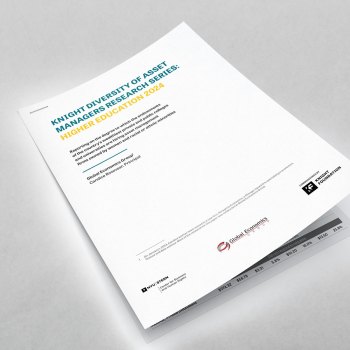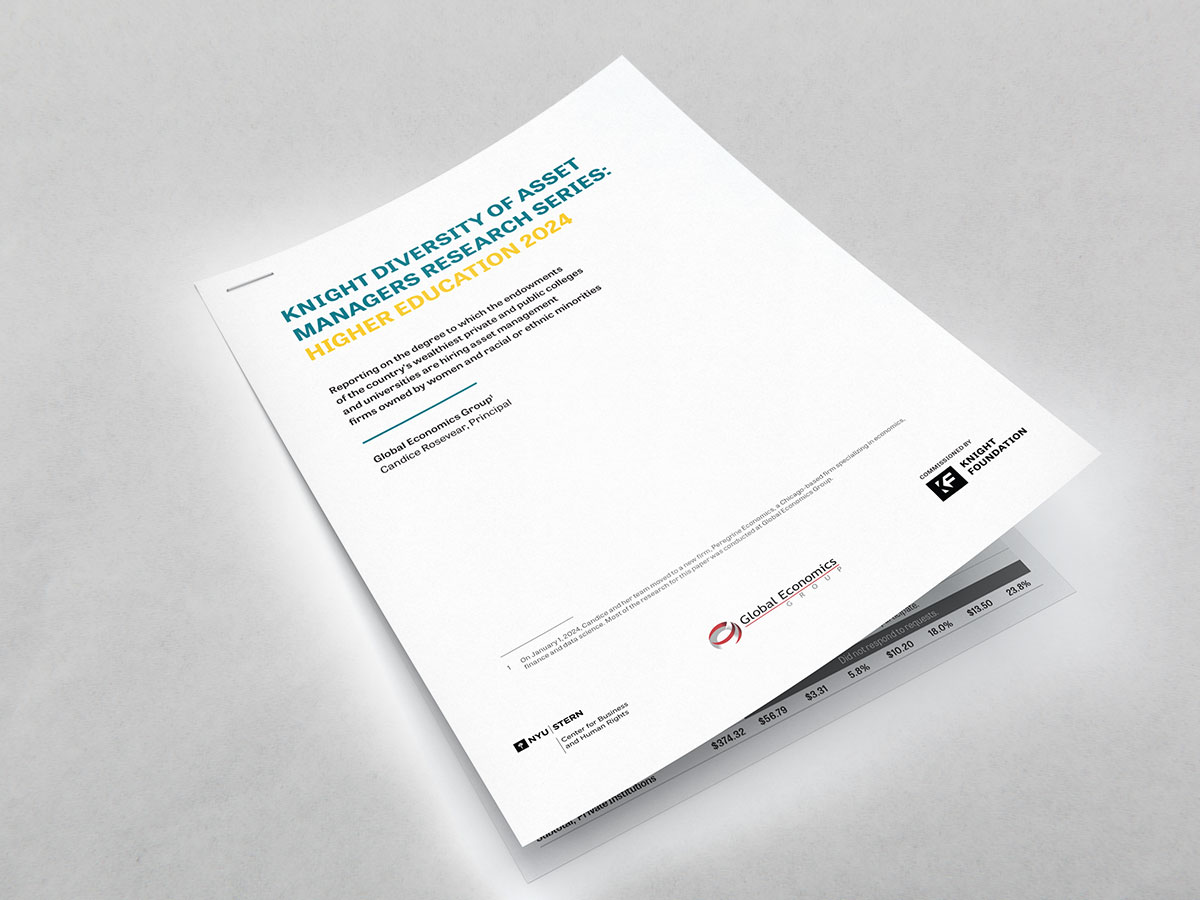
Two-year effort to compel colleges and universities to share endowment information spurs disappointment
Of the $566 billion managed by the wealthiest U.S. colleges and universities, the share handled by diverse-owned firms remains unknown.
In fall 2021, Knight Foundation set out to assess the degree to which the 50 wealthiest private and public U.S. colleges and universities (the 25 private and 25 public colleges and universities with the largest endowments) invest their endowment funds with diverse investment managers. Our partners in this study are Michael Posner and Kerin McCauley of the Center for Business and Human Rights at New York University’s Stern School of Business and Candice Rosevear of Peregrine Economics, formerly of Global Economics Group.
Most of the schools we contacted initially declined to participate. We kept trying for two years, using every tool at our disposal, but our success in gaining their participation has been limited. Only 18 of the 50 colleges and universities we contacted fully participated in the study. (Eight additional institutions chose to self-report their diversity statistics, using our study’s definitions.)
Why is this important? We believe equity and inclusion are a general good, and that should be reason enough to push for transparency regarding this type of information. As engines of opportunity and talent, universities should also want to know if their resources open opportunities for their students––specifically, students who want to pursue careers in finance and would benefit from an equitable job market––and for the communities that support them.
As Knight’s past research has consistently shown, a lack of transparency is an enormous barrier to increasing diversity and equity in the asset management industry. You can’t know where you stand, or if you need to make improvements if you don’t take measurements. We can’t see how we are progressing as a field if we don’t disclose our results.
A quick recap: Twelve years ago, the Knight Foundation first took a close look at the percentage of our own endowment that was managed by diverse-owned firms, and we were dismayed at how small that percentage was. We made changes internally to bring more diversity to our asset management.
Today, we are proud to have a high-performing endowment of about $2.5 billion, with over a third of it (almost $1 billion) overseen by asset management firms owned primarily by women and/or people of color. The change in our asset managers didn’t happen overnight—it took a decade of careful planning and execution. That included sponsoring several research studies on the diversity of asset managers in the U.S.’s $80-plus trillion market.
In our initial research, we learned that only about 1% of all assets under management in the U.S. are managed by diverse-owned firms (the total is now about 1.4%), even though these firms represent approximately 12.2% of U.S.-based asset managers. And we also learned that those who chose to invest with firms owned by women and/or people of color were not sacrificing results for the sake of values. Our own experience bore this out. This was a story we wanted to share with others, to stimulate a conversation about how well leading philanthropies live up to their stated values of equity and inclusion.
Since we began to report on this subject, some of our peer foundations have also significantly increased their investments with diverse managers. We celebrate the fact that the Robert Wood Johnson Foundation has the most invested with diverse-owned firms, at $1.64 billion, and that several other foundations have more than a third of their U.S.-based assets invested with diverse-owned firms.
We were then encouraged by multiple stakeholders to ask the same question of another group of similarly endowed institutions who serve the public: colleges and universities. But even as public-facing institutions, universities historically are not transparent about their financial affairs. Since foundations are required to provide some level of investment detail and public access to their tax returns, we started with a leg up in our research in that area. There is no similar requirement for colleges and universities.
Schools have a public purpose. Increasing the returns on their investments means more funds available for scholarships, professors’ salaries, programs, buildings—all the infrastructure that makes American schools strong and provides their students with an excellent education and access to opportunities. We believe that by concentrating their wealth in the hands of a small and homogeneous group of people, our country’s colleges and universities are missing out on the chance to get the best possible returns on their investments. And since our research has shown that diverse-owned firms are three times more likely to have diverse investment teams, universities are failing to support institutions that can provide more opportunities for their students.
Our hope was to receive enough data to allow us to publish a full report. We designed the process to make it as easy as possible for colleges and universities to participate. In our first attempt, 12 schools responded fully: they provided our independent researcher, Global Economics Group (GEG), with a list of their asset managers and the current market value of the assets managed by each manager. GEG used that data to calculate the percentage of their U.S.-based assets that are managed by diverse-owned firms. This not only reduced work for participants but also guaranteed the confidentiality of their data.
Four schools self-reported—that is, they performed the analysis themselves using our calculation method and gave us a final score, which we were not able to independently validate.
The rest of the schools—34 institutions, representing $273 billion in assets, declined to participate.
We did not have enough data to publish the kind of full report that we are known for; instead, we published an interim report in June 2022. In September 2022, we contacted the 50 schools to notify them that we were sponsoring a campaign with U.S News and World Report, honoring the institutions that were participating in our research. At the same time, we spoke out about the lack of transparency in the field and redoubled our efforts to find out more.
Our persistence has had some effect. Since we published our interim report in June 2022, six additional universities, all public, have contributed data; four more institutions (two public and two private) are now self-reporting. This increase is mainly due to our use of counsel specializing in public records requests. Only one public institution, Virginia Commonwealth University (VCU), responded without the pressure of a public records request.
Here’s how we went about increasing participation in the second report:
Schools that had not participated were encouraged to take advantage of a second chance to provide us with their data.
That fall, some student newspapers covered our interim report, including the Daily at the University of Washington, the Commonwealth Times at VCU, and the Yale Daily News. We can’t say whether this coverage had a direct effect, but University of Washington eventually did provide us with all the data we requested. (VCU self-reported, and Yale declined to participate.)
There was not much more we could do to convince the private institutions on our list to participate. However, we felt that there was a higher bar for public universities as state actors, and we had another channel to pursue. We attempted to use state public records acts, modeled on the federal Freedom of Information Act, which affirms the public’s right to see government documents.
We engaged Taft, and in December 2022 they began making requests for information from the target public universities, using the relevant public records statutes. The process, which involved dozens and dozens of hours of both their time and ours, continued well into 2023.
A few schools responded immediately and fully. Some were reluctant but over time cooperated fully or at least provided partial information. And in some states, where public universities are not subject to public records requests, we hit a wall. Some of those states have carved out exceptions that protect foundations at public universities from responding to requests. As these universities are funded by the state, we feel there is no justification for the information to be withheld from the public.
The University of Michigan, University of Washington, The Ohio State University, and University of Missouri all participated in response to these public records requests. The University of Nebraska and University of Minnesota responded with partial data. Some states, including Florida and North Carolina, don’t have protection from public record requests but have avoided responding by ping ponging us from one office to another.
In June and July 2023, we sent individualized reminders and made phone calls to all the institutions, public and private, that had not yet responded. When several schools notified us that they could not meet our deadline of July 31, we extended the deadline to October 31 to accommodate them.
Despite all these efforts, we still did not succeed in gathering sufficient information to publish the kind of full study we would have liked to release. One of the principles Knight has pursued in this work has been to publish public and academically rigorous reports that could add to knowledge of the field. In particular, we had hoped to create a benchmark for the group, like we have in our study of foundations, but we do not have enough participants to do so.
The private institutions on our list have, on average, funds that are three times the size of the public universities. Those that did respond to us responded well and early, and we’re grateful for the data they provided.
Most schools that did not participate at least let us know that they would not comply with our requests. Two schools—MIT and Boston College—simply ignored all requests, no matter how often they were contacted by our partners at the Center for Business and Human Rights at NYU. And unlike with public universities, we had no legal recourse.
Some schools that responded but refused to share data with us pointed to the importance of maintaining confidentiality around their strategy. However, we addressed the confidentiality issue in the structure of our process. Our researcher has a confidentiality agreement with Knight and we only report aggregate figures.
Some of the schools that declined to participate claimed that they do care about or pursue diversity in their investment managers.
For example, the University of Notre Dame commented: “Notre Dame does not disclose the names of its investment partners and therefore declined to participate in the study. Notre Dame strongly supports, and is working to promote, the goals of increasing diversity, equity and inclusion in the asset management industry. Notre Dame’s Investment Office works hard to find skilled firms to execute our investment strategy. As part of that search and diligence process, we have been very welcoming of minority- and women-owned firms. A broad mix of asset managers from around the globe have been retained by the University, including firms that are owned by women and minorities.”
The schools that did not participate are obviously reluctant to share their data for various reasons, but we should discuss some reasons why investors might be reluctant to invest with diverse-owned firms.
One reason may be the false belief that you will lose money if you invest with firms that are diverse. Perhaps these asset managers are not as savvy, this mistaken thinking goes; perhaps the firms are smaller and therefore less than excellent. We have tackled that argument directly in our previous research and, as we mentioned earlier, we have found that statistically there isn’t a distinction. But, while investment access in some top firms may be limited, we have found that highly productive smaller firms still have investment capacity.
Another argument is that there aren’t enough diverse managers. The gap we mentioned earlier between the percent of assets managed by diverse firms and the percentage of diverse firms in operation is one response to that argument. But another issue is the vicious cycle of lack of opportunity. The schools we contacted should be graduating a steady stream of diverse, highly educated candidates who are well prepared to take jobs with, and eventually run, investment firms. If there are no jobs there for them, they will find opportunities in other fields and the schools will have completed a self-fulfilling prophecy.
We’ve tried to tackle all the arguments. But in the end, we have concluded that most universities do not want to discuss diversity in this area. Two years after we began this study, we don’t have the data we need. But we will continue to have this conversation—that’s why we’re publishing an updated report along with this article.
Our mission is to provide facts that allow for an informed and engaged conversation on this important issue. We’re not advocating for a specific numerical goal; however, we are advocating for transparency, and ultimately for these colleges and universities to consider the investment opportunities reflected in the diversity of their asset managers.
Related Content
Knight Diversity of Asset Managers Research Series: Higher Education 2024
Recent Content
-
Artsarticle ·
-
Information and Societyarticle ·
-
Information and Societyarticle ·





